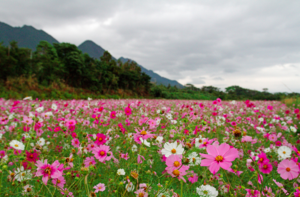
A flower is the reproductive part of flowering plants, division Magnoliophyta, or angiosperms.[1]
Fruit and seeds originate from flowers.
Flowers attract pollinators including insects, mammals and reptiles, dependent on their location and interrelationship. This helps the pollen to be transferred far more widely than the plant itself could manage.
Flowers are both cultivated and wild. Wildflowers is a term that tends to refer to flowers that were not intentionally grown or sown by human beings, or that have not been changed in any way by human manipulation.
Structure of a flower[edit | edit source]
Flowers are the reproductive organs of angiosperm plants. The female part of the flower is the pistil, while the male part is referred to as the stamen.
The pistil contains three parts: the ovary, the style and the stigma. The stigma is the receptive surface found at the top of the pistil. It receives the pollen from the male parts of the flower. The stigma is connected to the ovary by the style, which is tube shaped. Within the ovary reside the egg cells that turn into seeds when fertilised. After fertilisation, the ovary matures into fruit.
The stamen consists of the anther and the filament. The anther produces and releases the pollen grains that supply sperm cells to fertilise the ovules. Typically, the anther is located on the end of either a stalk or a filament.
Not all flowers are bisexual (containing both male and female reproductive parts within the one flower). Some flowers are unisexual, and will be either a female (pistillate) or a male (staminate) flower only. If both male and female flowers exist on the one plant, it is termed monoecious. If the plant only has all female or all male flowers, they are called dioecious.
In addition to the reproductive areas of a flower, the flower has petals and sepals. Sepals are the small green leaves that protect the flower bud as it develops. Petals are actually modified leaves and they are typically arranged the flower's reproductive organs. Their colours, size and patterns are often used to attract insect pollinators. They are a pretty, yet superfluous addition to the flower as far as reproduction is concerned. However, their beauty has no doubt helped many a flowering plant thrive due to the human species' love of beauty in the garden context.
Uses of flowers[edit | edit source]
Human beings have many uses for flowers including landscaping, culinary, scent, floristry (floral arrangements), medicine, romance, ritual, decoration and beauty.